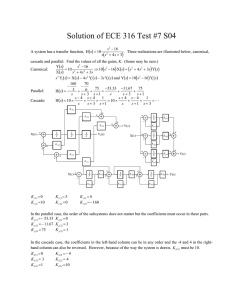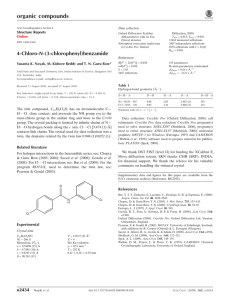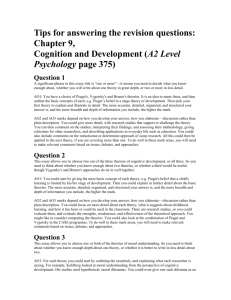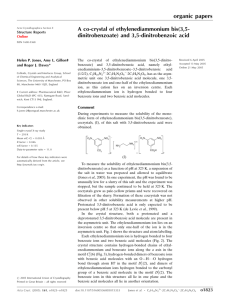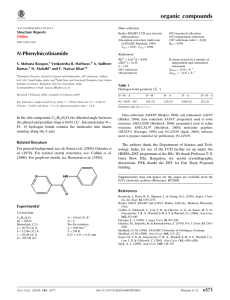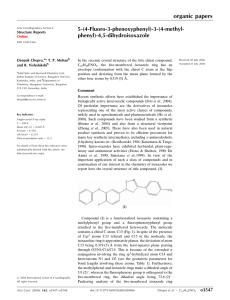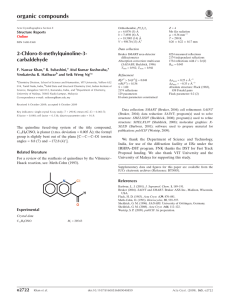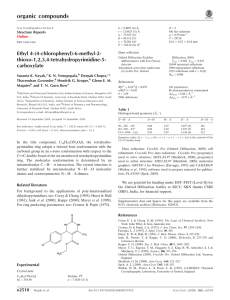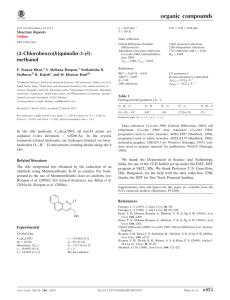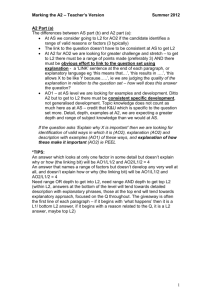Document 13512068
advertisement
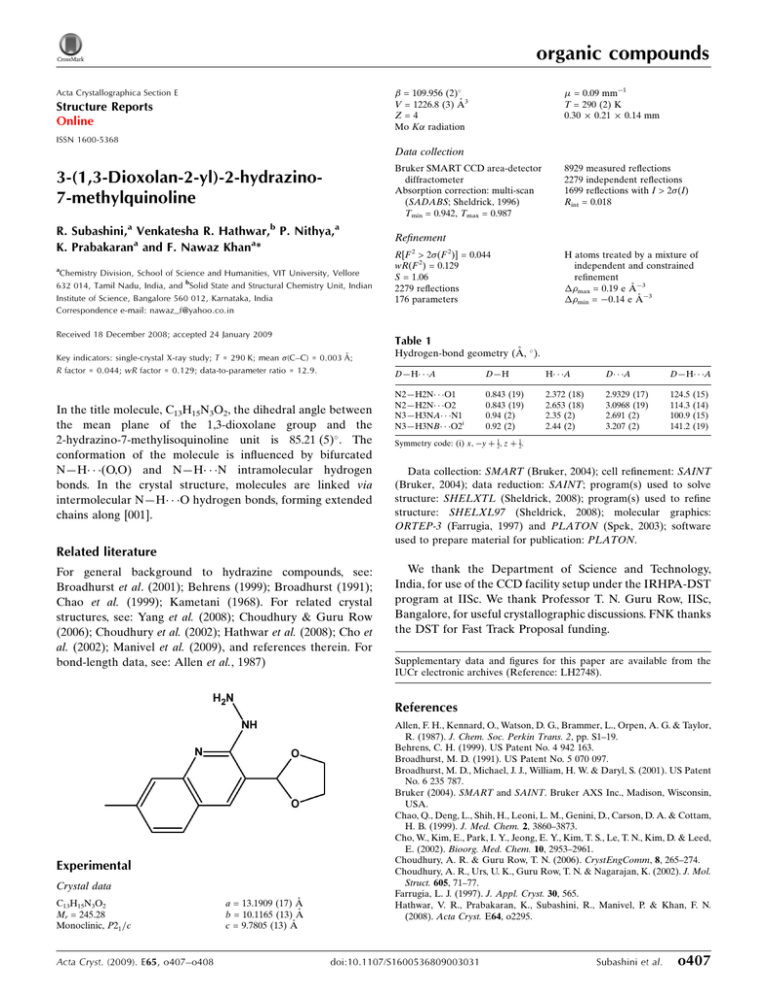
organic compounds = 0.09 mm1 T = 290 (2) K 0.30 0.21 0.14 mm = 109.956 (2) V = 1226.8 (3) Å3 Z=4 Mo K radiation Acta Crystallographica Section E Structure Reports Online ISSN 1600-5368 Data collection 3-(1,3-Dioxolan-2-yl)-2-hydrazino7-methylquinoline Bruker SMART CCD area-detector diffractometer Absorption correction: multi-scan (SADABS; Sheldrick, 1996) Tmin = 0.942, Tmax = 0.987 R. Subashini,a Venkatesha R. Hathwar,b P. Nithya,a K. Prabakarana and F. Nawaz Khana* Refinement a Chemistry Division, School of Science and Humanities, VIT University, Vellore 632 014, Tamil Nadu, India, and bSolid State and Structural Chemistry Unit, Indian Institute of Science, Bangalore 560 012, Karnataka, India Correspondence e-mail: nawaz_f@yahoo.co.in Received 18 December 2008; accepted 24 January 2009 R[F 2 > 2(F 2)] = 0.044 wR(F 2) = 0.129 S = 1.06 2279 reflections 176 parameters 8929 measured reflections 2279 independent reflections 1699 reflections with I > 2(I) Rint = 0.018 H atoms treated by a mixture of independent and constrained refinement max = 0.19 e Å3 min = 0.14 e Å3 Table 1 Key indicators: single-crystal X-ray study; T = 290 K; mean (C–C) = 0.003 Å; R factor = 0.044; wR factor = 0.129; data-to-parameter ratio = 12.9. In the title molecule, C13H15N3O2, the dihedral angle between the mean plane of the 1,3-dioxolane group and the 2-hydrazino-7-methylisoquinoline unit is 85.21 (5) . The conformation of the molecule is influenced by bifurcated N—H (O,O) and N—H N intramolecular hydrogen bonds. In the crystal structure, molecules are linked via intermolecular N—H O hydrogen bonds, forming extended chains along [001]. Hydrogen-bond geometry (Å, ). D—H A D—H H A D A D—H A N2—H2N O1 N2—H2N O2 N3—H3NA N1 N3—H3NB O2i 0.843 (19) 0.843 (19) 0.94 (2) 0.92 (2) 2.372 (18) 2.653 (18) 2.35 (2) 2.44 (2) 2.9329 (17) 3.0968 (19) 2.691 (2) 3.207 (2) 124.5 114.3 100.9 141.2 (15) (14) (15) (19) Symmetry code: (i) x; y þ 12; z þ 12. Data collection: SMART (Bruker, 2004); cell refinement: SAINT (Bruker, 2004); data reduction: SAINT; program(s) used to solve structure: SHELXTL (Sheldrick, 2008); program(s) used to refine structure: SHELXL97 (Sheldrick, 2008); molecular graphics: ORTEP-3 (Farrugia, 1997) and PLATON (Spek, 2003); software used to prepare material for publication: PLATON. Related literature For general background to hydrazine compounds, see: Broadhurst et al. (2001); Behrens (1999); Broadhurst (1991); Chao et al. (1999); Kametani (1968). For related crystal structures, see: Yang et al. (2008); Choudhury & Guru Row (2006); Choudhury et al. (2002); Hathwar et al. (2008); Cho et al. (2002); Manivel et al. (2009), and references therein. For bond-length data, see: Allen et al., 1987) We thank the Department of Science and Technology, India, for use of the CCD facility setup under the IRHPA-DST program at IISc. We thank Professor T. N. Guru Row, IISc, Bangalore, for useful crystallographic discussions. FNK thanks the DST for Fast Track Proposal funding. Supplementary data and figures for this paper are available from the IUCr electronic archives (Reference: LH2748). References Experimental Crystal data C13H15N3O2 Mr = 245.28 Monoclinic, P21 =c Acta Cryst. (2009). E65, o407–o408 a = 13.1909 (17) Å b = 10.1165 (13) Å c = 9.7805 (13) Å Allen, F. H., Kennard, O., Watson, D. G., Brammer, L., Orpen, A. G. & Taylor, R. (1987). J. Chem. Soc. Perkin Trans. 2, pp. S1–19. Behrens, C. H. (1999). US Patent No. 4 942 163. Broadhurst, M. D. (1991). US Patent No. 5 070 097. Broadhurst, M. D., Michael, J. J., William, H. W. & Daryl, S. (2001). US Patent No. 6 235 787. Bruker (2004). SMART and SAINT. Bruker AXS Inc., Madison, Wisconsin, USA. Chao, Q., Deng, L., Shih, H., Leoni, L. M., Genini, D., Carson, D. A. & Cottam, H. B. (1999). J. Med. Chem. 2, 3860–3873. Cho, W., Kim, E., Park, I. Y., Jeong, E. Y., Kim, T. S., Le, T. N., Kim, D. & Leed, E. (2002). Bioorg. Med. Chem. 10, 2953–2961. Choudhury, A. R. & Guru Row, T. N. (2006). CrystEngComm, 8, 265–274. Choudhury, A. R., Urs, U. K., Guru Row, T. N. & Nagarajan, K. (2002). J. Mol. Struct. 605, 71–77. Farrugia, L. J. (1997). J. Appl. Cryst. 30, 565. Hathwar, V. R., Prabakaran, K., Subashini, R., Manivel, P. & Khan, F. N. (2008). Acta Cryst. E64, o2295. doi:10.1107/S1600536809003031 Subashini et al. o407 organic compounds Kametani, T. (1968). The Chemistry of the Isoquinoline Alkaloids. Tokyo, Amsterdam: Hirokawa, Elsevier. Manivel, P., Hathwar, V. R., Nithya, P., Prabakaran, K. & Khan, F. N. (2009). Acta Cryst. E65, o137–o138. o408 Subashini et al. C13H15N3O2 Sheldrick, G. M. (1996). SADABS. University of Göttingen, Germany. Sheldrick, G. M. (2008). Acta Cryst. A64, 112–122. Spek, A. L. (2003). J. Appl. Cryst. 36, 7–13. Yang, Y., Yang, P., Zhang, C. & Wu, B. (2008). Anal. Sci. 24, x97–x98. Acta Cryst. (2009). E65, o407–o408 supporting information supporting information Acta Cryst. (2009). E65, o407–o408 [doi:10.1107/S1600536809003031] 3-(1,3-Dioxolan-2-yl)-2-hydrazino-7-methylquinoline R. Subashini, Venkatesha R. Hathwar, P. Nithya, K. Prabakaran and F. Nawaz Khan S1. Comment The title compound (I), belongs to the quinoline class. Quinolines and quinolinones are an integral part of many naturally occurring fused heterocycles and find application in synthetic and pharmaceutical chemistry (Kametani, 1968). Isoquinolinones and isoquinolineamines have been reported as cancer chemotherapeutic agents (Behrens, 1999) whereas quinolyl and isoquinolyl derivatives have been reported as insecticidal compounds (Broadhurst, 1991). 3-substituted isoquinolines have potent use in medicine (Chao et al., 1999) and in general, hydrazine derivatives can be used as medicaments (Broadhurst et al., 2001; Choudhury, et al., 2002; Choudhury & Guru Row, 2006; Yang, et al., 2008). Due to the importance of quinoline derivates (Cho et al., 2002) and in continuous of our research on quinolines and isoquinoline derivatives (Hathwar et al., 2008; Manivel et al., 2009) we present here crystal structure of the title compound. In (I) the dihedral angle between 1,3-dioxolane moiety and 2 hyrazino-7-methyl isoquinoline unit is 85.21 (5)°. All bond lengths (Allen et al., 1987) and angles are within normal ranges. The conformation of the molecule is influenced by N— H···O and N—H···N intramolecular hydrogen bonds whereas the crystal structure is stabilized by intermolecular N— H···O hydrogen bonds forming exteded chains along [001]. S2. Experimental A solution of 2-chloro (3-(1,3-dioxolan-2-yl)-7-methylquinoline in ethanol was treated with hydrazine hydrate and stirred at 323 K for 3hr. The product was filtered. The solid was washed with water and diethyl ether and dried under vacuum. Single crystals were obtained by recrystalization of (I) from DMSO. S3. Refinement All H atoms positioned geometrically and refined using a riding model with bond lengths C—H = 0.93 Å (for aromatic), 0.97 Å (for methylene) and 0.96 Å (for methyl). The Uiso(H) = 1.5Ueq(C) for methyl and Uiso(H) = 1.2Ueq(C) for all other carbon bound H atoms. H atoms bonded to N atoms were located in difference Fourier maps and refined isotropically. Acta Cryst. (2009). E65, o407–o408 sup-1 supporting information Figure 1 The molecular structure of (I) with 50% probability displacement ellipsoids. Dashed lines indicate hydrogen bonds. Figure 2 Part of the crystal structure of (I) showing hydrogen bonds as dashed lines. H atoms not involved in hydrogen bonds have been omitted. 3-(1,3-Dioxolan-2-yl)-2-hydrazino-7-methylquinoline Crystal data C13H15N3O2 Mr = 245.28 Monoclinic, P21/c Hall symbol: -P 2ybc Acta Cryst. (2009). E65, o407–o408 a = 13.1909 (17) Å b = 10.1165 (13) Å c = 9.7805 (13) Å β = 109.956 (2)° sup-2 supporting information V = 1226.8 (3) Å3 Z=4 F(000) = 520 Dx = 1.328 Mg m−3 Mo Kα radiation, λ = 0.71073 Å Cell parameters from 948 reflections θ = 1.8–24.6° µ = 0.09 mm−1 T = 290 K Block, brown 0.30 × 0.21 × 0.14 mm Data collection Bruker SMART CCD area-detector diffractometer Radiation source: fine-focus sealed tube Graphite monochromator φ and ω scans Absorption correction: multi-scan (SADABS; Sheldrick, 1996) Tmin = 0.942, Tmax = 0.987 8929 measured reflections 2279 independent reflections 1699 reflections with I > 2σ(I) Rint = 0.018 θmax = 25.5°, θmin = 1.6° h = −15→15 k = −10→12 l = −11→11 Refinement Refinement on F2 Least-squares matrix: full R[F2 > 2σ(F2)] = 0.044 wR(F2) = 0.129 S = 1.06 2279 reflections 176 parameters 0 restraints Primary atom site location: structure-invariant direct methods Secondary atom site location: difference Fourier map Hydrogen site location: inferred from neighbouring sites H atoms treated by a mixture of independent and constrained refinement w = 1/[σ2(Fo2) + (0.072P)2 + 0.1104P] where P = (Fo2 + 2Fc2)/3 (Δ/σ)max < 0.001 Δρmax = 0.19 e Å−3 Δρmin = −0.14 e Å−3 Special details Geometry. All esds (except the esd in the dihedral angle between two l.s. planes) are estimated using the full covariance matrix. The cell esds are taken into account individually in the estimation of esds in distances, angles and torsion angles; correlations between esds in cell parameters are only used when they are defined by crystal symmetry. An approximate (isotropic) treatment of cell esds is used for estimating esds involving l.s. planes. Refinement. Refinement of F2 against ALL reflections. The weighted R-factor wR and goodness of fit S are based on F2, conventional R-factors R are based on F, with F set to zero for negative F2. The threshold expression of F2 > σ(F2) is used only for calculating R-factors(gt) etc. and is not relevant to the choice of reflections for refinement. R-factors based on F2 are statistically about twice as large as those based on F, and R- factors based on ALL data will be even larger. Fractional atomic coordinates and isotropic or equivalent isotropic displacement parameters (Å2) O1 O2 N1 N2 N3 C1 C2 C3 H3A C4 x y z Uiso*/Ueq 0.10652 (9) 0.09919 (10) 0.32415 (10) 0.14264 (11) 0.12501 (13) 0.24495 (12) 0.26133 (12) 0.36404 (13) 0.3772 0.56033 (15) 0.42297 (12) 0.22186 (13) 0.45872 (13) 0.45599 (16) 0.53613 (19) 0.42351 (15) 0.35152 (15) 0.31857 (15) 0.2726 0.32091 (18) −0.28334 (11) −0.18872 (12) 0.15262 (13) 0.02767 (15) 0.13548 (18) 0.03448 (15) −0.08326 (15) −0.06896 (17) −0.1435 0.0793 (2) 0.0621 (4) 0.0701 (4) 0.0524 (4) 0.0597 (4) 0.0664 (4) 0.0464 (4) 0.0480 (4) 0.0550 (4) 0.066* 0.0688 (5) Acta Cryst. (2009). E65, o407–o408 sup-3 supporting information H4A C5 H5A C6 C7 H7A C8 C9 C10 H10A H10B H10C C11 H11A C12 H12A H12B C13 H13A H13B H2N H3NB H3NA 0.5778 0.64009 (14) 0.7111 0.61719 (14) 0.51244 (13) 0.4966 0.42773 (12) 0.45173 (12) 0.70689 (16) 0.6767 0.7481 0.7530 0.17109 (13) 0.2010 −0.00343 (14) −0.0588 −0.0228 0.00918 (15) 0.0146 −0.0513 0.0904 (15) 0.1453 (18) 0.1821 (17) 0.2750 0.35734 (19) 0.3344 0.4286 (2) 0.46184 (19) 0.5107 0.42464 (15) 0.35270 (15) 0.4661 (3) 0.4936 0.5372 0.3911 0.31376 (16) 0.2745 0.2421 (2) 0.2540 0.1675 0.3653 (2) 0.3440 0.4247 0.4447 (17) 0.484 (2) 0.597 (2) 0.0080 0.2051 (2) 0.2186 0.3145 (2) 0.29207 (17) 0.3628 0.16556 (16) 0.05728 (17) 0.4525 (2) 0.5244 0.4329 0.4882 −0.21833 (17) −0.2879 −0.2979 (2) −0.2544 −0.3640 −0.37670 (19) −0.4706 −0.3910 −0.050 (2) 0.218 (2) 0.158 (2) 0.083* 0.0732 (6) 0.088* 0.0662 (5) 0.0615 (5) 0.074* 0.0496 (4) 0.0533 (4) 0.0949 (8) 0.142* 0.142* 0.142* 0.0540 (4) 0.065* 0.0782 (6) 0.094* 0.094* 0.0764 (6) 0.092* 0.092* 0.064 (5)* 0.095 (7)* 0.078 (6)* Atomic displacement parameters (Å2) O1 O2 N1 N2 N3 C1 C2 C3 C4 C5 C6 C7 C8 C9 C10 C11 C12 C13 U11 U22 U33 U12 U13 U23 0.0577 (7) 0.0667 (8) 0.0475 (8) 0.0476 (8) 0.0626 (10) 0.0467 (8) 0.0497 (9) 0.0580 (10) 0.0566 (10) 0.0424 (9) 0.0518 (10) 0.0526 (10) 0.0480 (9) 0.0474 (9) 0.0550 (11) 0.0531 (9) 0.0554 (11) 0.0565 (11) 0.0724 (8) 0.0722 (8) 0.0647 (9) 0.0838 (11) 0.0782 (11) 0.0495 (9) 0.0465 (8) 0.0492 (9) 0.0607 (11) 0.0707 (12) 0.0774 (13) 0.0785 (12) 0.0526 (9) 0.0470 (9) 0.138 (2) 0.0597 (10) 0.0901 (15) 0.1135 (17) 0.0494 (6) 0.0642 (7) 0.0438 (7) 0.0443 (7) 0.0586 (9) 0.0426 (8) 0.0470 (8) 0.0589 (9) 0.0890 (13) 0.0974 (14) 0.0628 (11) 0.0512 (9) 0.0470 (8) 0.0629 (10) 0.0771 (13) 0.0492 (9) 0.0852 (13) 0.0500 (9) 0.0026 (6) −0.0201 (6) −0.0047 (6) 0.0051 (7) 0.0087 (9) 0.0001 (7) 0.0006 (7) 0.0019 (7) 0.0055 (8) 0.0022 (8) −0.0136 (9) −0.0134 (8) −0.0057 (7) 0.0001 (7) −0.0265 (12) −0.0007 (7) −0.0112 (10) 0.0012 (11) 0.0095 (5) 0.0130 (6) 0.0141 (6) 0.0114 (6) 0.0211 (7) 0.0145 (7) 0.0153 (7) 0.0214 (8) 0.0245 (9) 0.0122 (9) 0.0108 (8) 0.0148 (8) 0.0147 (7) 0.0156 (7) 0.0040 (10) 0.0175 (7) 0.0188 (10) 0.0065 (8) 0.0034 (5) −0.0040 (6) −0.0015 (6) −0.0113 (7) −0.0131 (9) 0.0037 (6) 0.0012 (6) −0.0077 (7) −0.0053 (10) 0.0105 (11) 0.0122 (9) 0.0024 (8) 0.0065 (7) 0.0035 (7) 0.0078 (13) −0.0083 (7) −0.0274 (12) −0.0119 (11) Acta Cryst. (2009). E65, o407–o408 sup-4 supporting information Geometric parameters (Å, º) O1—C11 O1—C13 O2—C12 O2—C11 N1—C1 N1—C8 N2—C1 N2—N3 N2—H2N N3—H3NB N3—H3NA C1—C2 C2—C3 C2—C11 C3—C9 C3—H3A C4—C5 C4—C9 1.4074 (19) 1.422 (2) 1.424 (2) 1.427 (2) 1.3151 (18) 1.372 (2) 1.3683 (19) 1.411 (2) 0.843 (19) 0.92 (2) 0.94 (2) 1.440 (2) 1.355 (2) 1.495 (2) 1.417 (2) 0.9300 1.368 (3) 1.411 (2) C4—H4A C5—C6 C5—H5A C6—C7 C6—C10 C7—C8 C7—H7A C8—C9 C10—H10A C10—H10B C10—H10C C11—H11A C12—C13 C12—H12A C12—H12B C13—H13A C13—H13B 0.9300 1.406 (3) 0.9300 1.365 (3) 1.509 (2) 1.406 (2) 0.9300 1.407 (2) 0.9600 0.9600 0.9600 0.9800 1.504 (3) 0.9700 0.9700 0.9700 0.9700 C11—O1—C13 C12—O2—C11 C1—N1—C8 C1—N2—N3 C1—N2—H2N N3—N2—H2N N2—N3—H3NB N2—N3—H3NA H3NB—N3—H3NA N1—C1—N2 N1—C1—C2 N2—C1—C2 C3—C2—C1 C3—C2—C11 C1—C2—C11 C2—C3—C9 C2—C3—H3A C9—C3—H3A C5—C4—C9 C5—C4—H4A C9—C4—H4A C4—C5—C6 C4—C5—H5A C6—C5—H5A C7—C6—C5 C7—C6—C10 C5—C6—C10 104.05 (14) 106.35 (14) 118.70 (13) 120.87 (13) 120.1 (12) 117.4 (12) 104.8 (14) 102.9 (12) 101.6 (18) 116.89 (14) 123.28 (14) 119.82 (13) 117.35 (13) 119.66 (14) 122.99 (13) 121.34 (15) 119.3 119.3 120.33 (18) 119.8 119.8 121.55 (17) 119.2 119.2 118.21 (16) 121.57 (19) 120.22 (17) N1—C8—C7 N1—C8—C9 C7—C8—C9 C8—C9—C4 C8—C9—C3 C4—C9—C3 C6—C10—H10A C6—C10—H10B H10A—C10—H10B C6—C10—H10C H10A—C10—H10C H10B—C10—H10C O1—C11—O2 O1—C11—C2 O2—C11—C2 O1—C11—H11A O2—C11—H11A C2—C11—H11A O2—C12—C13 O2—C12—H12A C13—C12—H12A O2—C12—H12B C13—C12—H12B H12A—C12—H12B O1—C13—C12 O1—C13—H13A C12—C13—H13A 118.75 (15) 122.22 (14) 119.03 (15) 118.70 (15) 117.09 (14) 124.20 (16) 109.5 109.5 109.5 109.5 109.5 109.5 105.16 (13) 112.04 (13) 111.79 (13) 109.2 109.2 109.2 105.10 (14) 110.7 110.7 110.7 110.7 108.8 104.14 (14) 110.9 110.9 Acta Cryst. (2009). E65, o407–o408 sup-5 supporting information C6—C7—C8 C6—C7—H7A C8—C7—H7A 122.15 (17) 118.9 118.9 O1—C13—H13B C12—C13—H13B H13A—C13—H13B 110.9 110.9 108.9 Hydrogen-bond geometry (Å, º) D—H···A D—H H···A D···A D—H···A N2—H2N···O1 N2—H2N···O2 N3—H3NA···N1 N3—H3NB···O2i 0.843 (19) 0.843 (19) 0.94 (2) 0.92 (2) 2.372 (18) 2.653 (18) 2.35 (2) 2.44 (2) 2.9329 (17) 3.0968 (19) 2.691 (2) 3.207 (2) 124.5 (15) 114.3 (14) 100.9 (15) 141.2 (19) Symmetry code: (i) x, −y+1/2, z+1/2. Acta Cryst. (2009). E65, o407–o408 sup-6
